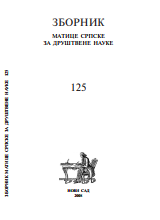БРАЧНО ПРАВО У ВОЈВОДИНИ ИЗМЕÐУ ДВА СВЕТСКА РАТА
LAW ON MARRIAGE IN VOJVODINA IN THE PERIOD BETWEEN TWO WORLD WARS
Author(s): Olga Cvejić JančićSubject(s): Law, Constitution, Jurisprudence, Geography, Regional studies, History of Law, Civil Law, Family and social welfare, Interwar Period (1920 - 1939)
Published by: Матица српска
Keywords: Marriage; engagement; marriage annoyance; marriage prohibitions; formalities for the conclusion of marriage;
Summary/Abstract: The conditions for marriage under the prewar law in Vojvodina were numerous and more complex than in our contemporary law. In the prevailing part of Vojvodina in that time there was in effect the Hungarian Family Law Act from 1894 by which civil marriage was introduced and religious differences were abolished as a marriage impediment. Religious form of marriage was still in effect in Srem and in those parts of Vojvodina which were before unification under Austrian jurisdiction (Military Border). Cohabitation was not recognized and had no family law effects. Legal status of the children born out of wedlock was much worse than the legal status of the children born in wedlock. Discrimination on the ground of sex was a rule, not only in the law of Vojvodina, but also in other parts of The Kingdom of Yugoslavia. For example, women could get married only with the dispensation of the minister of justice, at the age of 16, while men could get married at 18. Woman was subordinate to her husband and could legally represent only her children born out of wedlock. She could exceptionally be the legal representative of her children born in wedlock.
Journal: Зборник Матице српске за друштвене науке
- Issue Year: 2008
- Issue No: 125
- Page Range: 33-52
- Page Count: 20
- Language: Serbian

